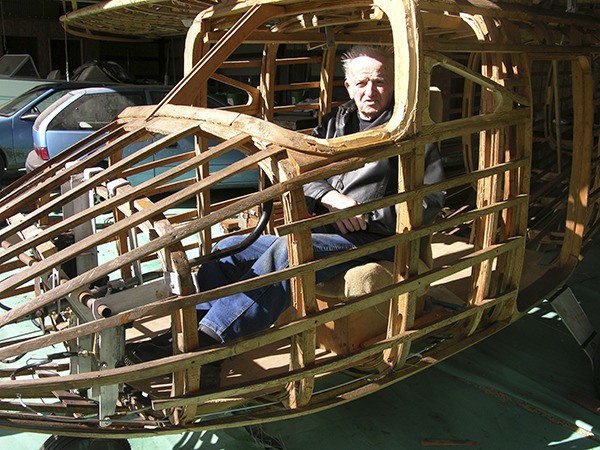The wood frame is Sitka spruce, shipped from Alaska then steam-bent by hand using a home-built steam box. Half-inch aluminum, bent with the aid of only a vice, makes up the engine mounts and the stays for landing gear.
Frank Wajda of Sequim has been tenderly hand-crafting the Alaska-style bush plane for the past 14 years.
His eyesight failing and he wants to hand the project over to someone who can complete, or at least preserve, his work.
For 40 of his 93 years, Wajda built boats in Wrangell, Alaska, hence his skill at steam-bending wood. This is the first plane he has attempted, but he has aircraft experience of the most intimate sort.
Desert, war and pigeons
The son of Polish immigrants, Wajda enlisted early in World War II from his home in Chicopee Falls, Mass., and spent the years 1941-1945 as a mechanic with the 12th Bombardment Group, 82nd Squadron. As ground personnel, the young enlistee joined joined thousands of other soldiers on the overseas trip from the U.S. around the Cape of Good Hope and up to Suez, part of an effort to relieve British forces recently defeated at Tobruk by German Field Marshal Erwin Rommel.
In the war for North Africa, Wajda spent most nights camped in a two-man tent under the wing of a B-25 medium range bomber. He serviced the planes by day and guarded them from sabotage and air attack by night, moving with the planes through Egypt, Libya and Tunisia.
Wajda recalls days when the planes were too hot to work on, followed by dust storms “thick as night and black as hell.”
The 82nd weren’t the only fliers out there: One night a carrier pigeon waddled into Wajda’s little tent; Wajda and his buddy turned the banded visitor and its message over to the proper authority.
Once Rommel’s campaign was demolished, the squadron was sent on to Italy, India and the Burma theater.
A Buick to Alaska
Cpl. Wajda took a lot of chaff during the war about his oft-expressed determination to go to Alaska. Once he was rotated back to the U.S. in 1945 and discharged, he made good on that dream, heading out in a 1929 Buick. At Seattle he sold the car to purchase a spot on the boat to Ketchikan, Alaska, then flew by small plane to Wrangell. There he found work in carpentry until he built cabinets for a cabin owned by Olaf Anson. The boatbuilder hired Wajda to build boats.
“It took me about seven years to really learn how to build a boat,” he said. But in his career, Wajda built 82 boats of wood, two of steel and one of aluminum.
While working for Anson, Wajda met and married his wife Martha, and the two had a daughter. In 1974 the family moved to Sequim. Wajda had built three houses in Alaska and he was to build nine more in Sequim, one with an all-wood spiral staircase. He also built three milking parlors for local dairies.
In 1997, Wajda built a last boat and sailed it from Sequim to Alaska and back.
Dream to lend
Since that trip, Wajda’s major project has been the creation of a true-flying Alaska bush plane. On the property where he lives near his daughter, Cathy Martineau, Wajda began sketching out the design and building plans, then ordered the wood from Alaska and started work.
The plane’s framework is complete, sculpturally beautiful as it sits, but meant to be clad in a skin of 5/32-inch plywood and mounted with two Corvair or Rotamax engines. The plane has a 36-foot wingspan, a 21-foot fuselage and a height of seven feet. The 15-degree sweptback wings have a 14-inch dihedral, curving 14 inches higher at the tip than near the fuselage. With torque tube controls and a tri-cycle landing gear, the plane is ready for completion.
“To begin with, I wanted to fly it,” said Wajda. When problems with his eyesight arose, he knew flying the plane was impossible. Now he is ready to crane up the wing section, move the plane out of the barn and see his work taken over by someone who shares his skills and his dreams.



